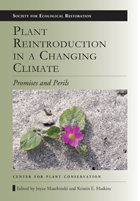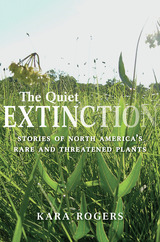3 books about Endangered plants

Plant Reintroduction in a Changing Climate
Promises and Perils
Edited by Joyce Maschinski and Kristin E. Haskins
Island Press, 2011
Considered an essential conservation tool, plant reintroductions have been conducted for many of the world's rarest plant species. The expertise and knowledge gained through these efforts constitute an essential storehouse of information for conservationists faced with a rapidly changing global climate.
This volume presents a comprehensive review of reintroduction projects and practices, the circumstances of their successes or failures, lessons learned, and the potential role for reintroductions in preserving species threatened by climate change. Contributors examine current plant reintroduction practices, from selecting appropriate source material and recipient sites to assessing population demography.
The findings culminate in a set of Best Reintroduction Practice Guidelines, included in an appendix. These guidelines cover stages from planning and implementation to long-term monitoring, and offer not only recommended actions but also checklists of questions to consider that are applicable to projects around the world.
Traditional reintroduction practice can inform managed relocation-the deliberate movement of species outside their native range-which may be the only hope for some species to persist in a natural environment. Included in the book are discussions of the history, fears, and controversy regarding managed relocation, along with protocols for evaluating invasive risk and proposals for conducting managed relocation of rare plants.
Plant Reintroduction in a Changing Climate is a comprehensive and accessible reference for practitioners to use in planning and executing rare plant reintroductions.
This volume presents a comprehensive review of reintroduction projects and practices, the circumstances of their successes or failures, lessons learned, and the potential role for reintroductions in preserving species threatened by climate change. Contributors examine current plant reintroduction practices, from selecting appropriate source material and recipient sites to assessing population demography.
The findings culminate in a set of Best Reintroduction Practice Guidelines, included in an appendix. These guidelines cover stages from planning and implementation to long-term monitoring, and offer not only recommended actions but also checklists of questions to consider that are applicable to projects around the world.
Traditional reintroduction practice can inform managed relocation-the deliberate movement of species outside their native range-which may be the only hope for some species to persist in a natural environment. Included in the book are discussions of the history, fears, and controversy regarding managed relocation, along with protocols for evaluating invasive risk and proposals for conducting managed relocation of rare plants.
Plant Reintroduction in a Changing Climate is a comprehensive and accessible reference for practitioners to use in planning and executing rare plant reintroductions.
[more]

The Quiet Extinction
Stories of North America’s Rare and Threatened Plants
Kara Rogers
University of Arizona Press, 2015
In the United States and Canada, thousands of species of native plants are edging toward the brink of extinction, and they are doing so quietly. They are slipping away inconspicuously from settings as diverse as backyards and protected lands. The factors that have contributed to their disappearance are varied and complex, but the consequences of their loss are immeasurable.
With extensive histories of a cast of familiar and rare North American plants, The Quiet Extinction explores the reasons why many of our native plants are disappearing. Curious minds will find a desperate struggle for existence waged by these plants and discover the great environmental impacts that could come if the struggle continues.
Kara Rogers relates the stories of some of North America’s most inspiring rare and threatened plants. She explores, as never before, their significance to the continent’s natural heritage, capturing the excitement of their discovery, the tragedy that has come to define their existence, and the remarkable efforts underway to save them. Accompanied by illustrations created by the author and packed with absorbing detail, The Quiet Extinction offers a compelling and refreshing perspective of rare and threatened plants and their relationship with the land and its people.
With extensive histories of a cast of familiar and rare North American plants, The Quiet Extinction explores the reasons why many of our native plants are disappearing. Curious minds will find a desperate struggle for existence waged by these plants and discover the great environmental impacts that could come if the struggle continues.
Kara Rogers relates the stories of some of North America’s most inspiring rare and threatened plants. She explores, as never before, their significance to the continent’s natural heritage, capturing the excitement of their discovery, the tragedy that has come to define their existence, and the remarkable efforts underway to save them. Accompanied by illustrations created by the author and packed with absorbing detail, The Quiet Extinction offers a compelling and refreshing perspective of rare and threatened plants and their relationship with the land and its people.
[more]

Restoring Diversity
Strategies For Reintroduction Of Endangered Plants
Edited by Donald A. Falk, Constance I. Millar, and Margaret Olwell; Foreword byReed F. Noss
Island Press, 1996
In April 1993, a national conference sponsored by the Center for Plant Conservation brought together academic biologists, agency staff members, activists, and other experts to critically explore the value of ecological restoration as a conservation strategy. Restoring Diversity examines and expands on issues set forth at that gathering. Topics covered include: the strategic and legal context for rare plant restoration the biology of restoration use (and misuse) of mitigation in rare plant conservation case studies from across the United States Restoring Diversity is a pathbreaking work that not only unifies concepts in the field of restoration, but also fills significant technical and policy gaps, and provides operational tools for successful restorations.
[more]
READERS
Browse our collection.
PUBLISHERS
See BiblioVault's publisher services.
STUDENT SERVICES
Files for college accessibility offices.
UChicago Accessibility Resources
home | accessibility | search | about | contact us
BiblioVault ® 2001 - 2025
The University of Chicago Press









